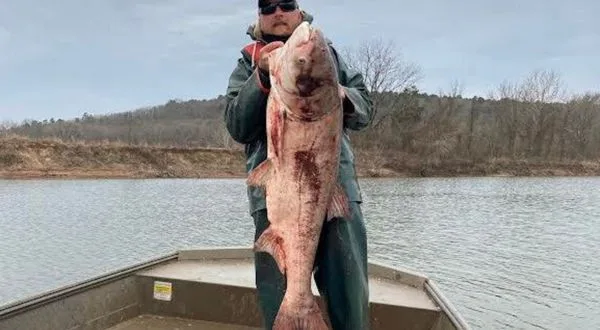
Nearly 50 years ago, catfish farmers in the Arkansas delta imported Asian carp to clean vegetation from ponds, making better habitats for the lucrative fish crop.It sounded like good practice. Carp eat nearly their weight each day and the plankton and plants that were detrimental to catfish disappeared. More farms popped up in eastern Arkansas along the Mississippi River and its oxbows. Business thrived.
But in what sounds like a plot from a cheesy 1950s science fiction movie, carp escaped those ponds due to flooding and improper management and got into the Mississippi River. In the 25 years since those first fish found freedom, millions of carp began moving northward up the river, into the Illinois River and now the Chicago River, eating everything they could find and now threatening the sport fishing industry in Lake Michigan.
“Officials drug their feet on this,” said Dave Thomas, a commercial fisherman from Forrest City who has seen the glut of carp hurt his business. “There’s no fixing it. These fish are here to stay.”
“If something doesn’t happen, we’re going to lose all our native fish,” he said.
Although there isn’t a real way to count the number of invasive carp in the waterways, Jimmy Barnett, a fish biologist with the Arkansas Game and Fish Commission and the agency’s invasive species coordinator, says there are “millions” out there.
Wildlife officers have found carp in 28 states, he said.
“They reproduce in high volumes,” Barnett said.
Rapid reproduction
The first carp in Arkansas were released into commercial catfish ponds and sewage lagoons in 1973. The intent was for the fish to become “filter feeders,” cleaning habitat for catfish and removing algae blooms and controlling weeds at wastewater treatment plants.
About 150 to 200 carp were first used in Arkansas. A second batch went to Illinois to be used for the same purpose, Barnett said.
Two years later, in the summer of 1975, the first rogue carp appeared in the White River near its confluence with the Arkansas River.
“From that point on, they began spreading out,” Barnett said. “The Mississippi River had ideal conditions for the carp.”
The fish began reproducing rapidly and causing problems. Areas that once were rife with bream, bass and crappie – fish that Arkansas sport fishers enjoyed catching – were vanishing because of depleted habitats.
Carp migrated from the eastern Arkansas oxbows and have been found in the Spring, Eleven Point and Black rivers in the northern part of the state, as far west as the Arkansas River in Dardanelle and as far south as the Red River in Texarkana.
“They keep moving,” Barnett said. “They eat up everything. When there’s no groceries left for them, they move on.”
Fishing hazards
Kentucky reported a serious problem with carp and began contracting commercial fishermen to capture them. Millions of pounds of carp were removed.
In addition to their voracious appetites, carp also pose a dangerous hazard. When frightened by noises such as boat motors, the 30-pound fish often leap out of the water. Plenty of videos available on YouTube attest to that, showing hundreds of flying carp jumping into boats and striking boaters.
Thomas said a carp leapt from the water of a Mississippi River oxbow recently and struck his driver, breaking his nose.
The carp have also punched Thomas’ pocketbook.
“Eighty percent of the fish I catch is invasive carp,” he said.
Recently, he netted 8,000 pounds of carp in one week.
“They’re everywhere,” he said. “They’re in every ditch whenever a river floods.”
By comparison, Thomas caught 3,000 pounds of buffalo fish the same week and only 800 pounds of catfish. He sold only 50 pounds of the carp that week.
The Arkansas Game and Fish Commission offers an 18-cent per pound bounty on carp, but it doesn’t cover the expenses of fishing, storing and either selling the fish locally or trying to export them, Thomas said.
“It’s not worth putting them in the boat,” Thomas said.
Rebranding effort
Thomas has talked with Asian businessmen about exporting them to China, Thailand, Korea and Japan where carp is considered a delicacy. The species is the most-eaten fish in the world.
However, U.S. diners turn up their noses at the carp because of their connotation as being nasty, bottom-feeding fish.
Arkansas has tried rebranding the fish, as has Illinois in an effort to reduce their population in an “if you can’t beat them, eat them” campaign.
The Illinois Department of Natural Resources gave the invasive species a new name of “copi,” in hopes that people will become interested in eating them. The name is derived from the word “copious,” which describes the overabundance of the fish.
“The ‘carp’ name is so harsh that people won’t even try it,” Kevin Irons, assistant fisheries chief for the Illinois Department of Natural Resources, told the Associated Press. “But it’s healthy, clean and it really tastes pretty darn good.”
Restaurants and other businesses in areas affected by the carp are suggesting recipes for copi tacos, copi burgers and smoked copi dip.
In a nod to racial sensitivity, officials also won’t call the species “Asian carp” anymore, preferring the less offensive “invasive carp.”
In addition to the state-offered bounty, the Arkansas Game and Fish Commission also contracted with professional netters in 2021. Commercial businesses worked four days a week, netting more than 350,000 pounds of carp a week from the White and Arkansas rivers.
But the fish remain.
“We want to eradicate them,” Barnett said. “But we’re hit with a bazillion of them.”
Northern migration
Now, half a century since their first release, the carp are headed to the Great Lakes.
They’ve been found 50 miles from Chicago and Lake Michigan, said Molly Flanagan, vice president of the Alliance For the Great Lakes.
“It could be devastating if the fish reach the lake,” she said.
Sport fishing on Lake Michigan is a $7 billion a year industry, Flanagan said. As a result, Illinois has created a $1.1 billion project aimed at keeping the lake free from the carp.
Chicago officials reversed the flow of the Chicago River in the early 1900s, sending the city’s sewage downstream to the Mississippi River rather than into Lake Michigan. The work also created an efficient channel or highway for the invasive fish to reach the lake when it connected the Chicago River to the Des Plaines River.
The Brandon Road Interbasin Project is a state-of-the-art barricade at the Brandon Road Lock and Dam on the Des Plaines River near Joliet, Illinois.
Experts will create an electric barrier that the fish cannot penetrate. Coupled with “bubble barriers,” which involve aeration to stop fish, an acoustical barrier using sound and closer monitoring of area rivers’ locks and dams, officials hope to save Lake Michigan.
“We are optimistic we will be able to prevent these invasive carp from getting into Lake Michigan,” Flanagan said.
It should take six to eight years to complete the project, she said.
Arkansas challenges
In the meantime, Arkansas officials are hoping to continue their own battle with the fish.
Because people won’t eat enough carp, Thomas said he’s now thinking of using the fish for fertilizer and for dog food. He plans to meet with potential investors to build fertilizer processing facilities and begin selling the product to farmers.
“The only way to control the fish is through commercial fishing,” he said. “But there’s no money in it. We’ve got to find other ways.”
To view this story, or more news updates from Arkansas Advocate, click here.
WebReadyTM Powered by WireReady® NSI










